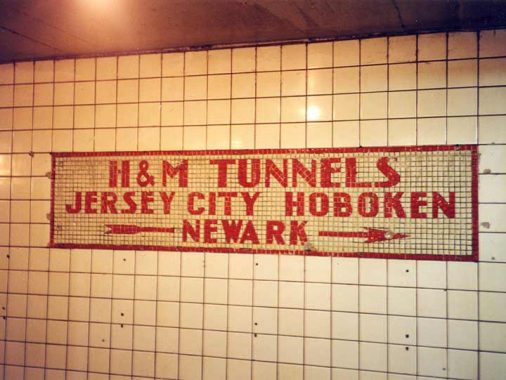
THE Port Authority Trans-Hudson Railroad, or the PATH train, is NYC’s “other” subway, running under 6th Avenue, Christopher Street, Greenwich Street and Morton Street and from Church Street at the World Trade Center site to various stops in Hoboken, Jersey City, and Newark, New Jersey. At its full length, it runs from one block away from NYC’s Pennsylvania Station to Newark’s Penn Station. At a $2.75 fare (now less than the $2.90 NYC subway fare), savvy city riders can save 15 cents traveling from Midtown to Greenwich Village (updated 9/23).
The PATH is the modern-day result of the first attempt to cross the mighty Hudson by placing railroad tracks in a tunnel. Engineer Dewitt Clinton Haskins drove a partial tunnel from the Jersey side beginning as early as 1874 but got only partway before an accident claimed 20 lives. A British firm took up the mantle in 1890, but again was forced to abandon the pursuit.
An ambitious lawyer from Georgia via Tennessee, William Gibbs McAdoo (1863-1941), obtained backing and employed upgraded tunneling methods in 1901, proceeding to do what by then was considered impossible: he engineered multiple tunnels and inaugurated rail service, the first trans-Hudson rail of its kind, between NYC and Hoboken, from 1908-1910 and Jersey City and Newark Park Place in 1911. Newark Penn Station service was added to what was called the Hudson and Manhattan Railroad in 1937. Original service ran between Hoboken and 19th Street (now closed to the general public) and opened February 25, 1908. The H&M was, in effect, the original 6th Avenue Subway — Independent Subway 6th Avenue service did not open until December 15, 1940.
The H&M was, in part, responsible for the old World Trade Center. The railroad had fallen into bankruptcy in the 1950s, but The Port Authority agreed to purchase and maintain the Hudson Tubes in return for the rights to build the World Trade Center on the land occupied by H&M’s Hudson Terminal (the “original” Twin Towers on Church Street), which was the Lower Manhattan terminus of the Tubes.
McAdoo , the son-in-law of U.S. President Woodrow Wilson, acted as Wilson’s Treasury Secretary from 1913 until 1919, raising millions for the US effort in WWI. He unsuccessfully ran twice for the Democratic presidential nomination in 1920 and 1924, and was later elected a US Senator from California in 1933, serving one 6-year term.
The PATH has its quirks. For one thing there’s a distinctive, musty aroma, that to me is not all that horrible, but I imagine plenty of folks aren’t fond of it. Despite a lot of modernization over the years, most stations do contain some elements of original “19-oughts” construction. Until 10-15 years ago the rolling stock was, in many cases, 1965 vintage. And, despite their proximity, much of Jersey City and Newark remain unplumbed and unexplored territory for my camera with Hoboken slightly less unknown, as I have spent a lot of time there and worked there in 2016.
The 14th Street station is a virtual sign museum. This is a surprisingly busy subway interchange, since the station also connects with the 7th Avenue IRT #1, 2, 3 lines via a pedestrian tunnel, and there’s also a subway (though not PATH) transfer to the crosstown BMT L line. Hence, IRT, IND, BMT, PATH all interact here.
The Independent Subway (IND) helpfully included directional signs to the H&M tunnels. These signs were unveiled in 1940. Again, the type is all business, no nonsense here. There was a depression on!
As always, “comment…as you see fit.” I earn a small payment when you click on any ad on the site. Take a look at the new JOBS link in the red toolbar at the top of the page on the desktop version, as I also get a small payment when you view a job via that link.
9/23/23
